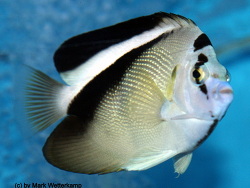Info
(Carlson & Taylor, 1981)
Apolemichthys griffisi is also known as the Griffis' Angelfish. It is a quite rare and exotic species and found in the Central and West Pacific; the Marshall, Line, Phoenix, Gilbert and Solomon Islands, Papua New Guinea and Indonesia.
Most of the Apolemichthys members are colorful but this species is rather simply colored. Being a mostly white and black fish and a bit more plain than many of the angelfishes. It is somewhat similar in coloration to the Bandit Angelfish Apolemichthys arcuatus from the Hawaiiian Islands, although these two fish are readily distinguishable from each other by the patterns of their markings.
The Griffis' Angelfish often occurs in pairs, but solitary individuals are also seen. They inhabit steep reef slopes at depths between 10 and 80-90 meters. Apolemichthys griffisi are omnivores, in the wild they feed primarily sponges and tunicates, but there is little data on their entire diet.
Though it would be a great addition to any type of aquarium, it is best kept in a fish only environment. It is also said to be a reef safe fish as it does well in a coral-rich tank with sessile inverts, but it may eat some species of hard and soft corals. Apolemichthys griffisi is not a quick swimmer but needs lots of open space for free swimming, it also needs nooks and crannies to hide in when a danger approaches.
Remarks:
Most large angelfish are well known for nipping at large-polyped stony corals and some soft corals as well as tridacnid clam mantles.
Classification: Biota > Animalia (Kingdom) > Chordata (Phylum) > Vertebrata (Subphylum) > Gnathostomata (Superclass) > Pisces (Superclass) > Actinopterygii (Class) > Perciformes (Order) > Pomacanthidae (Family) > Apolemichthys (Genus) > Apolemichthys griffisi (Species)
hma
Apolemichthys griffisi is also known as the Griffis' Angelfish. It is a quite rare and exotic species and found in the Central and West Pacific; the Marshall, Line, Phoenix, Gilbert and Solomon Islands, Papua New Guinea and Indonesia.
Most of the Apolemichthys members are colorful but this species is rather simply colored. Being a mostly white and black fish and a bit more plain than many of the angelfishes. It is somewhat similar in coloration to the Bandit Angelfish Apolemichthys arcuatus from the Hawaiiian Islands, although these two fish are readily distinguishable from each other by the patterns of their markings.
The Griffis' Angelfish often occurs in pairs, but solitary individuals are also seen. They inhabit steep reef slopes at depths between 10 and 80-90 meters. Apolemichthys griffisi are omnivores, in the wild they feed primarily sponges and tunicates, but there is little data on their entire diet.
Though it would be a great addition to any type of aquarium, it is best kept in a fish only environment. It is also said to be a reef safe fish as it does well in a coral-rich tank with sessile inverts, but it may eat some species of hard and soft corals. Apolemichthys griffisi is not a quick swimmer but needs lots of open space for free swimming, it also needs nooks and crannies to hide in when a danger approaches.
Remarks:
Most large angelfish are well known for nipping at large-polyped stony corals and some soft corals as well as tridacnid clam mantles.
Classification: Biota > Animalia (Kingdom) > Chordata (Phylum) > Vertebrata (Subphylum) > Gnathostomata (Superclass) > Pisces (Superclass) > Actinopterygii (Class) > Perciformes (Order) > Pomacanthidae (Family) > Apolemichthys (Genus) > Apolemichthys griffisi (Species)
hma







 dlaux
dlaux






















